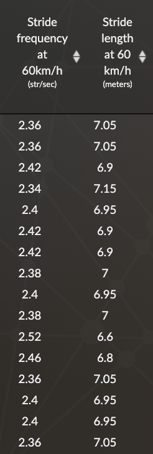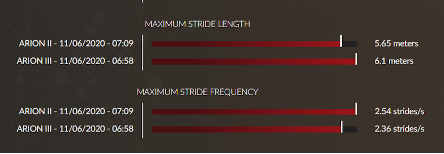To better understand the locomotor profile of a horse, the basis of the analysis is the study of stride length and stride frequency. They very often increase to the detriment of the other and their analysis allows to determine the preferred distance.
Discover good tips for locomotion analysis: cadence, amplitude, analytical tools and locomotor profiles.
1. Typical locomotor profiles
The stride frequency and stride length very often increase to the detriment of the other. Pace is often directly correlated with stamina: a high pace is difficult to sustain over a long period of time and will therefore hinder high stamina.
As each horse has its own style of stride, generic and theoretical profiles can be distinguished.
- Sprinter – Short distances
In order to reach a high speed quickly, a high stride frequency can be an advantage. Indeed, a high stride frequency makes it possible to reach maximum speed faster than a long but short-paced stride. However, high stride frequency will not be sustainable as long as a large and less frequent stride. Improving the quality of recovery and fitness of the horse will ensure that the horse can hold this high pace longer than other horses and thus win the sprint.
- Milers & Stayers – long distances
As the length of the race increases, so does the stamina. So a low pace will allow you to focus on stamina and stride length. Since speed is achieved through a longer stride, horses with locomotor skills for longer distances are distinguished by a high stride length and a low stride frequency that allows them to hold the length.
| Sprinter | Miler > 1600m | Stayer > 2400m | |
| Gait (stride/s) | More than 2.43 | Less than 2.4 | Less than 2.35 |
2. In practice, how to detect a horse's locomotor profile?
Go to the Analytics tool > columns stride length at 60 km/h & stride frequency at 60 km/h

In this example, we notice that the average stride rate of the horse at 60km/h is less than 2.4.
This means that this horse is a miler and should run in races from 1600m to 2300m. The Analytics functionality of the Equimetre platform helps to get a more precise idea of the horse’s locomotor profile and align him with races adapted to his profile.
3. Compare your horses
Thanks to the comparison tool, you can compare two horses and their locomotor profile.

By comparing a horse with another at a given speed, it is possible to determine if the horse prefers to work in stride frequency: he makes faster strides than the other, or in stride length: his strides are larger than normal.
In this example, Arion II is galloping at s=5.65 × 2.54=14.3 m/s (or 51.5 km/h) while Arion III is also galloping at s=6.1 × 2.36=14.3 m/s. Nevertheless, these two horses have completely different strategies: Arion II favors stride frequency and Arion III favors stride length.
